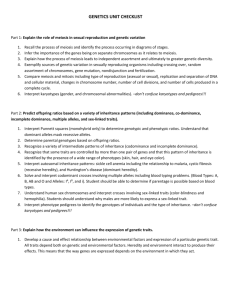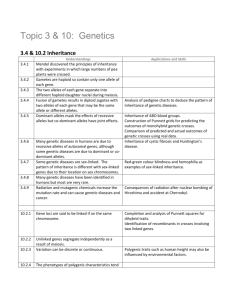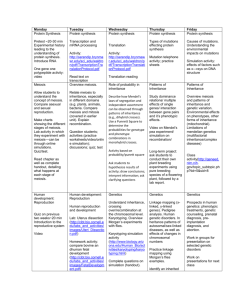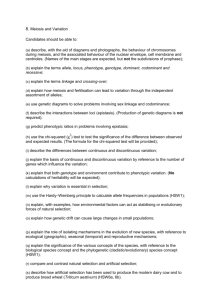18 Day Unit Plan - CIA-Biology-2011-2012
advertisement
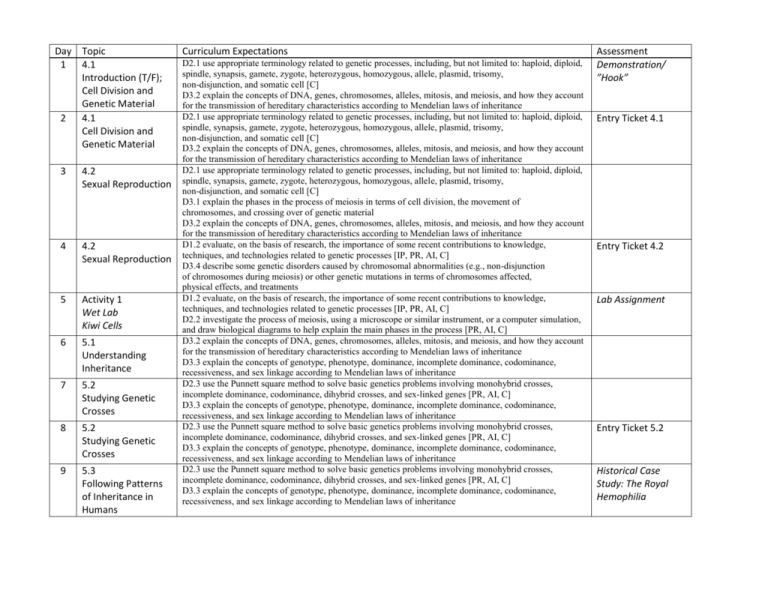
Day Topic 1 4.1 Introduction (T/F); Cell Division and Genetic Material 2 4.1 Cell Division and Genetic Material 3 4.2 Sexual Reproduction 4 4.2 Sexual Reproduction 5 Activity 1 Wet Lab Kiwi Cells 6 5.1 Understanding Inheritance 7 5.2 Studying Genetic Crosses 8 5.2 Studying Genetic Crosses 9 5.3 Following Patterns of Inheritance in Humans Curriculum Expectations D2.1 use appropriate terminology related to genetic processes, including, but not limited to: haploid, diploid, spindle, synapsis, gamete, zygote, heterozygous, homozygous, allele, plasmid, trisomy, non-disjunction, and somatic cell [C] D3.2 explain the concepts of DNA, genes, chromosomes, alleles, mitosis, and meiosis, and how they account for the transmission of hereditary characteristics according to Mendelian laws of inheritance D2.1 use appropriate terminology related to genetic processes, including, but not limited to: haploid, diploid, spindle, synapsis, gamete, zygote, heterozygous, homozygous, allele, plasmid, trisomy, non-disjunction, and somatic cell [C] D3.2 explain the concepts of DNA, genes, chromosomes, alleles, mitosis, and meiosis, and how they account for the transmission of hereditary characteristics according to Mendelian laws of inheritance D2.1 use appropriate terminology related to genetic processes, including, but not limited to: haploid, diploid, spindle, synapsis, gamete, zygote, heterozygous, homozygous, allele, plasmid, trisomy, non-disjunction, and somatic cell [C] D3.1 explain the phases in the process of meiosis in terms of cell division, the movement of chromosomes, and crossing over of genetic material D3.2 explain the concepts of DNA, genes, chromosomes, alleles, mitosis, and meiosis, and how they account for the transmission of hereditary characteristics according to Mendelian laws of inheritance D1.2 evaluate, on the basis of research, the importance of some recent contributions to knowledge, techniques, and technologies related to genetic processes [IP, PR, AI, C] D3.4 describe some genetic disorders caused by chromosomal abnormalities (e.g., non-disjunction of chromosomes during meiosis) or other genetic mutations in terms of chromosomes affected, physical effects, and treatments D1.2 evaluate, on the basis of research, the importance of some recent contributions to knowledge, techniques, and technologies related to genetic processes [IP, PR, AI, C] D2.2 investigate the process of meiosis, using a microscope or similar instrument, or a computer simulation, and draw biological diagrams to help explain the main phases in the process [PR, AI, C] D3.2 explain the concepts of DNA, genes, chromosomes, alleles, mitosis, and meiosis, and how they account for the transmission of hereditary characteristics according to Mendelian laws of inheritance D3.3 explain the concepts of genotype, phenotype, dominance, incomplete dominance, codominance, recessiveness, and sex linkage according to Mendelian laws of inheritance D2.3 use the Punnett square method to solve basic genetics problems involving monohybrid crosses, incomplete dominance, codominance, dihybrid crosses, and sex-linked genes [PR, AI, C] D3.3 explain the concepts of genotype, phenotype, dominance, incomplete dominance, codominance, recessiveness, and sex linkage according to Mendelian laws of inheritance D2.3 use the Punnett square method to solve basic genetics problems involving monohybrid crosses, incomplete dominance, codominance, dihybrid crosses, and sex-linked genes [PR, AI, C] D3.3 explain the concepts of genotype, phenotype, dominance, incomplete dominance, codominance, recessiveness, and sex linkage according to Mendelian laws of inheritance D2.3 use the Punnett square method to solve basic genetics problems involving monohybrid crosses, incomplete dominance, codominance, dihybrid crosses, and sex-linked genes [PR, AI, C] D3.3 explain the concepts of genotype, phenotype, dominance, incomplete dominance, codominance, recessiveness, and sex linkage according to Mendelian laws of inheritance Assessment Demonstration/ ”Hook” Entry Ticket 4.1 Entry Ticket 4.2 Lab Assignment Entry Ticket 5.2 Historical Case Study: The Royal Hemophilia 10 Activity 2 Dry Lab Dragon Activity 11 4.3 Reproductive Strategies and Technologies 4.3 Reproductive Strategies and Technologies 12 13 14 15 16 17 Computer Lab STSE – genetic technologies In Class Activity GMO Debate; Work Period - STSE Project REVIEW 4.1-5.3 Unit Test STSE Presentations D2.3 use the Punnett square method to solve basic genetics problems involving monohybrid crosses, incomplete dominance, codominance, dihybrid crosses, and sex-linked genes [PR, AI, C] D3.2 explain the concepts of DNA, genes, chromosomes, alleles, mitosis, and meiosis, and how they account for the transmission of hereditary characteristics according to Mendelian laws of inheritance D3.3 explain the concepts of genotype, phenotype, dominance, incomplete dominance, codominance, recessiveness, and sex linkage according to Mendelian laws of inheritance D1.1 analyse, on the basis of research, some of the social and ethical implications of research in genetics and genomics (e.g., genetic screening, gene therapy, in vitro fertilization) [IP, PR, AI, C] D1.2 evaluate, on the basis of research, the importance of some recent contributions to knowledge, techniques, and technologies related to genetic processes (e.g., research into the cystic fibrosis gene; the use of safflowers to produce insulin for human use) [IP, PR, AI, C] D1.1 analyse, on the basis of research, some of the social and ethical implications of research in genetics and genomics (e.g., genetic screening, gene therapy, in vitro fertilization) [IP, PR, AI, C] D1.2 evaluate, on the basis of research, the importance of some recent contributions to knowledge, techniques, and technologies related to genetic processes (e.g., research into the cystic fibrosis gene; the use of safflowers to produce insulin for human use) [IP, PR, AI, C] D3.5 describe some reproductive technologies (e.g., cloning, artificial insemination, in vitro fertilization, recombinant DNA), and explain how their use can increase the genetic diversity of a species (e.g., farm animals, crops) Dragon Activity Quiz 5.1-5.3 Recent Research Development Activity & Worksheet Exit Ticket A1.1 formulate relevant scientific questions about observed relationships, ideas, problems, or issues, make informed predictions, and/or formulate educated hypotheses to focus inquiries or research A1.3 identify and locate a variety of print and electronic sources that enable them to address research topics fully and appropriately A1.7 select, organize, and record relevant information on research topics from a variety of appropriate sources, including electronic, print, and human sources, using suitable formats and an accepted form of academic documentation A1.9 analyze the information gathered from research sources for logic, accuracy, reliability, adequacy, and bias A1.10 draw conclusions based on inquiry results and research findings, and justify their conclusions with reference to scientific knowledge A1.11 communicate ideas, plans, procedures, results, and conclusions orally, in writing, and/or in electronic presentations, using appropriate language and a variety of formats (e.g., data tables, laboratory reports, Unit Test 4.1-5.3 STSE Assignment 18 STSE Presentations presentations, debates, simulations, models) A1.12 use appropriate numeric, symbolic, and graphic modes of representation, and appropriate units of measurement (e.g., SI units, imperial units) A1.1 formulate relevant scientific questions about observed relationships, ideas, problems, or issues, make informed predictions, and/or formulate educated hypotheses to focus inquiries or research A1.3 identify and locate a variety of print and electronic sources that enable them to address research topics fully and appropriately A1.7 select, organize, and record relevant information on research topics from a variety of appropriate sources, including electronic, print, and human sources, using suitable formats and an accepted form of academic documentation A1.9 analyze the information gathered from research sources for logic, accuracy, reliability, adequacy, and bias A1.10 draw conclusions based on inquiry results and research findings, and justify their conclusions with reference to scientific knowledge A1.11 communicate ideas, plans, procedures, results, and conclusions orally, in writing, and/or in electronic presentations, using appropriate language and a variety of formats (e.g., data tables, laboratory reports, presentations, debates, simulations, models) A1.12 use appropriate numeric, symbolic, and graphic modes of representation, and appropriate units of measurement (e.g., SI units, imperial units) STSE Assignment

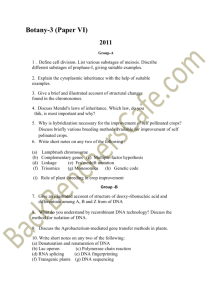
![[11.1,11.2,11.3] COMPLEX INHERITANCE and HUMAN HEREDITY](http://s3.studylib.net/store/data/006715925_1-acaa49140d3a16b1dba9cf6c1a80e789-300x300.png)


